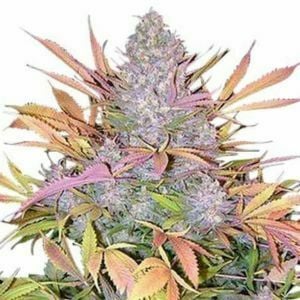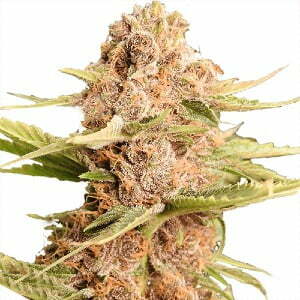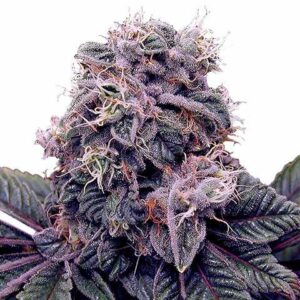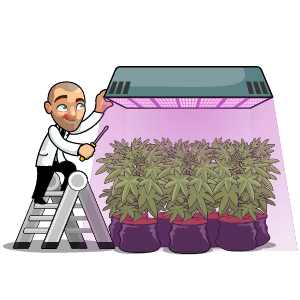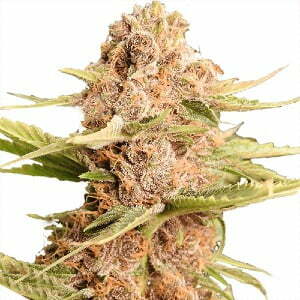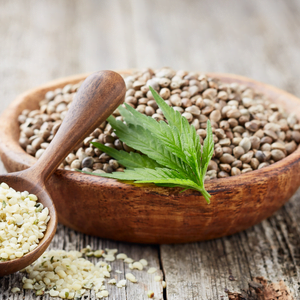Congratulations, you are about to begin your home gardening adventure. There are dozens of considerations to designing a custom grow room, from lighting to location to security, but don’t let that intimidate you. The ILGM family has your back with decades of growing experience in all sorts of garden spaces to help guide you through the process.
If you’re reading this, you’ve likely been looking at the different areas of your house and wondered, how do I convert this into a cannabis grow room?
This article will provide all the information needed to build an indoor cannabis grow room. Regardless of the available size, budget, or location, we’ve got you covered. Growing your own cannabis offers the rewards of saved costs and premium products if done correctly. ILGM wants you to succeed and to have fun doing it, which is why this article exists. Let’s get started!
Growing cannabis in a small space
Grow room designs exist for all sorts of footprints. How much space do you need? The best way to choose the ideal size is to determine how many plants you wish to grow. ILGM has hundreds of quality strains; unfortunately, we don’t have enough space to grow them all at once. You can find how many plants fit in different footprints by reading our article: how many plants can you grow in a grow tent?
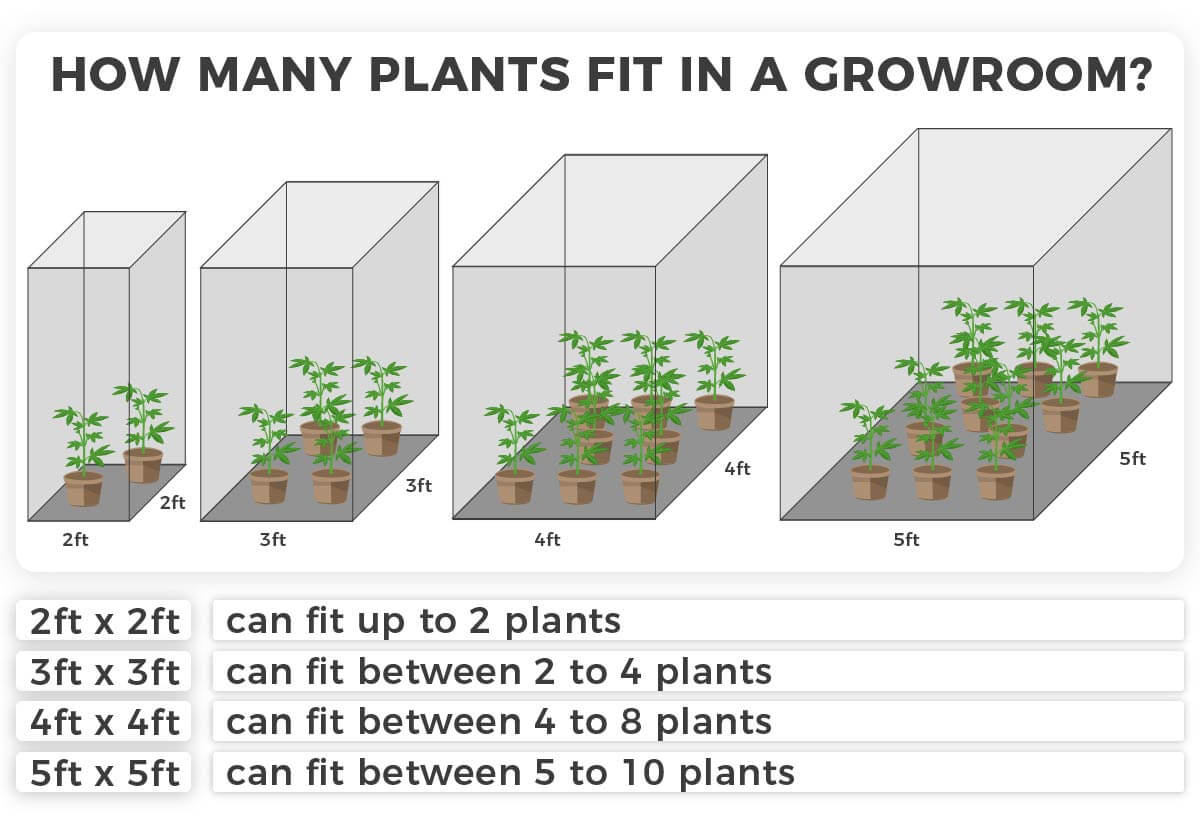

Let’s say you want to grow a couple of small plants discreetly in an out-of-the-way location or windowsill in your home. Perfect; check out our article on cannabis micro-growing that will walk you through the considerations and steps to growing weed in a small space.
This article, however, highlights grow room designs for converting a larger space into a marijuana grow room.
Choosing the perfect room
Some growers can choose which room is best for them instead of making the only available option work for them. How do you decide? Well, outdoor growers have a saying – work with nature, don’t fight it. If your designs fit naturally into one room instead of another, choose the path of less resistance.
Cannabis plants grow best in the right environment, and temperature is one of those important variables. For example, if you’re deciding between a room with exterior, southwest-facing walls or one without exterior-facing walls, choose the second. It is much easier to keep the room in the middle of the house cooler than one that gets the afternoon sun.
There are a variety of potential grow room locations in your home. Our article – The best places to grow cannabis in a house provides guidance on that topic.
What is the ideal grow room?
The best cannabis grow room plans will utilize a room that growers aren’t afraid to do a little customizing in. Growing cannabis can be messy, although we preach cleanliness. The fact is, there will be soil spilled and water splashed onto the floor.
Rooms with concrete floors are ideal for cleanliness, but most people don’t have concrete floors in the house, only in the garage. You can sweep wood floors, but they can also absorb and retain moisture from spills. Rooms with carpeting can harbor pests and pathogens. Grow tents and drip trays can help mitigate these problems indoors.
Aside from the size, flooring, and location, there are still many things to consider when building a grow room; for instance,
- Normal temperature fluctuations in the room (interior vs. exterior walls / north facing vs. south facing)
- Average humidity in the room
- Do windows need coverings to block light from escaping?
- How many electrical outlets are there, where are they located?
- Where will you exhaust the air?
- Is it accessible to strangers, kids, or pets?
It is advised to have your vision for the grow room design and grow system worked out in your head before beginning construction. How to set up a grow room can be different for different growing styles. Hydroponic growers will need a water source in the room or very close to the room due to the requirements of that growing style.
Soil growers can walk down the hall to fetch water every few days without much inconvenience. Accounting for these small details will help you pick the right room to use. Below, we’ve highlighted the top three places to build a cannabis grow space in a house.
Attic grow room
This is one of the most underused spaces in the entire house. Attics are tucked above the main living areas, which adds discreteness to their potential as a marijuana grow room. Growers can customize this space to suit their needs, and ventilating the used air is as simple as connecting the fan to an existing vent.
Controlling temperatures can be challenging, and if you live in areas with annual snowfall, the bare patch on your roof might give your grow operation away. We go in-depth on the best ways to convert an attic into a cannabis grow room in our article – Attic Grow Room Tips.
Basement grow room
Whether you have an open floorplan or the basement is divided into different rooms, being below ground has advantages and disadvantages. This is another commonly underutilized area of the house that, with a little bit of preparation, can be turned into an excellent marijuana grow room.
The floors are typically concrete, there aren’t many large windows for light to leak from, and basements are a relatively secure area of the home. Extra equipment, e.g., dehumidifiers, may be needed to combat basement moisture, but everything is manageable. You can learn all you need to know about basement grow room plans in our article – Basement grow room tips.
Garage grow room
Another area of the home that, with a little customization, can make an excellent cannabis growing space. Smells, messes, and intense lighting are removed from the main living area, reducing a grower’s stress levels when company visits. Garages are also secured by locking doors, which can be ideal for growers with curious children.
Uninsulated garages will require work to mitigate temperature swings, humidity, and pests; however, they usually have adequate electrical outlets. Breaker boxes are commonly in garages, making installing a new outlet easier if needed. You can find the full list of pros and cons of growing marijuana in a garage in our article – Garage Grow Room Tips.
Equipment needed to build your grow room
For growers who like to make lists of materials and tools, the equipment needed to build a grow room can be divided into two sections: materials for construction and materials for growing. Obviously, you should purchase the materials for constructing your grow room first. However, remember that they both are coming from the same budget. It helps to have the big picture in mind.
If you are converting an existing room inside the house, most of the construction is already finished. My number one suggestion would be to buy a room-sized tent (8ft x 8ft [244cm x 244cm] or 10ft x 12ft [305cm x 366cm] ) or two large tents (4ft x 8ft [122cm x 244cm] ) for growers who want to run a perpetual garden. The large grow tent solution offers a drip tray for spills, reflective walls, and a frame to hang lights and other equipment.
If converting an open room, growers will need
- a stud finder to locate ceiling joists to hang lights
- white paint or mylar to increase the reflectivity of the walls
- floor covering like tarps, linoleum pieces, or large drip containers that hold several pots
- blackout curtains and velcro if the room has windows
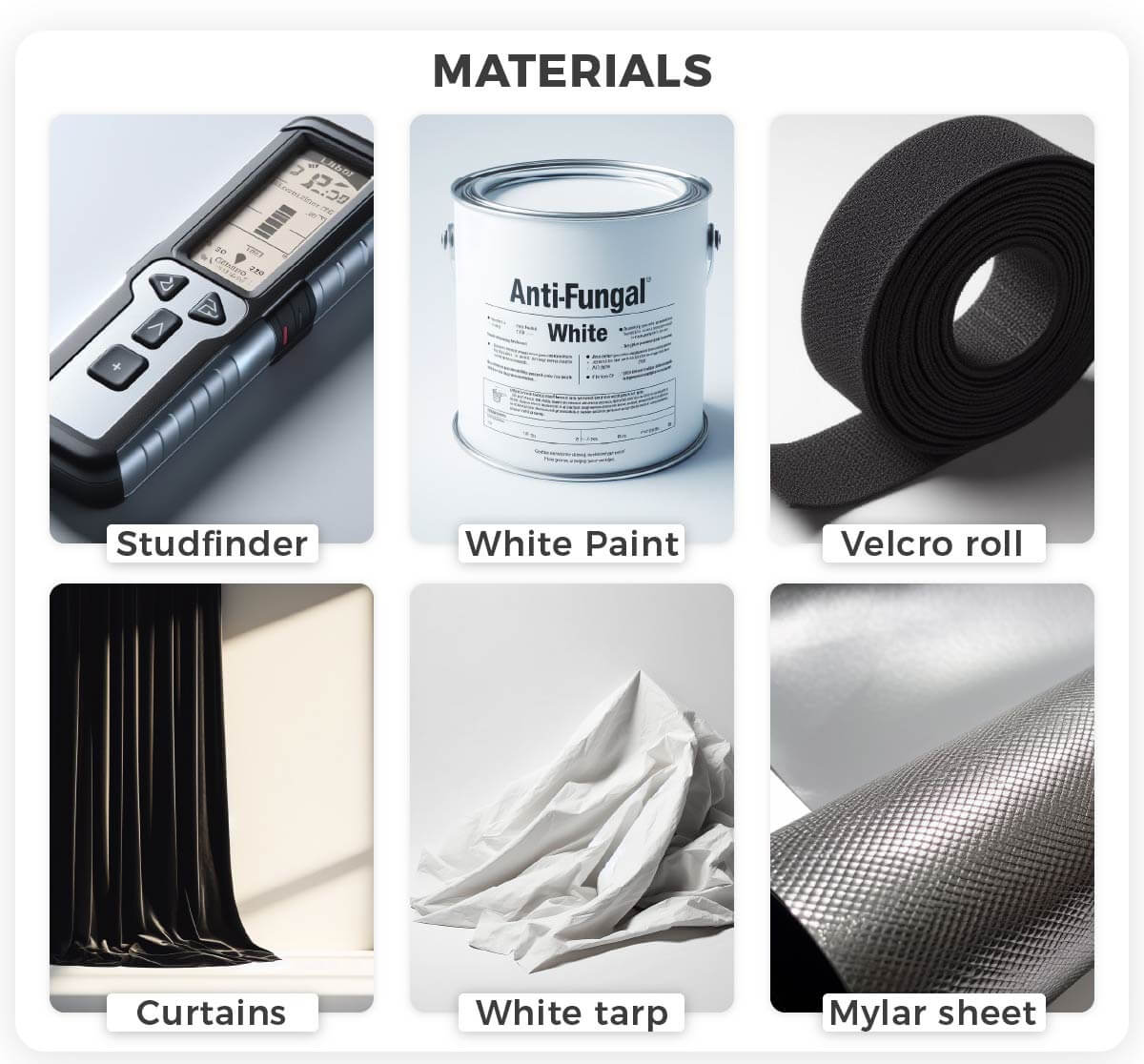

Depending on the location and how well the walls are insulated, a few more items may be important. Items for controlling the environment, including
- dehumidifier
- humidifier
- portable Air Conditioning
- portable heater
- circulating fans
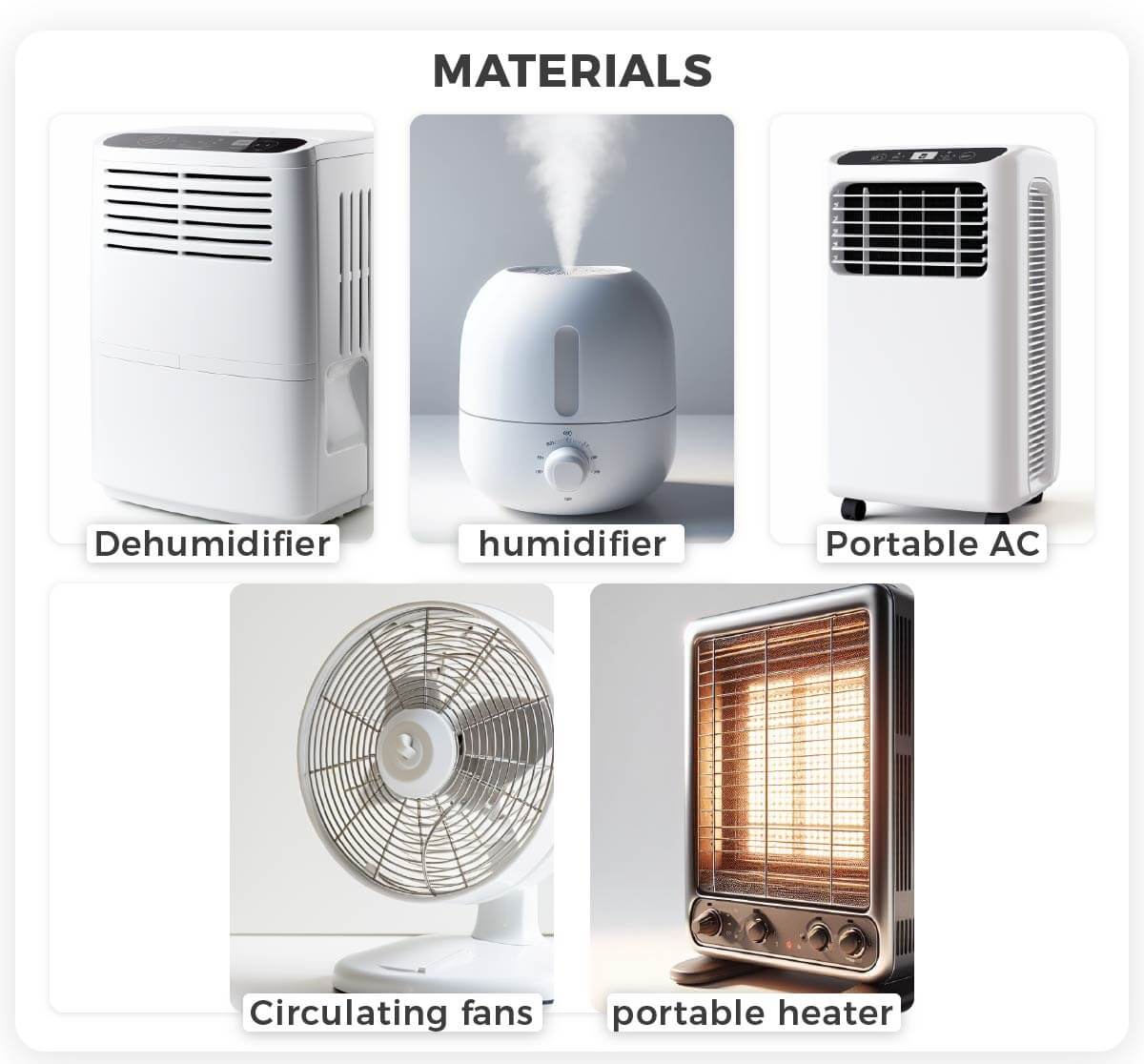

To complete the picture, we’ve created an article for cost-conscious consumers titled – How to set up a low-budget grow room. In that article, you will find advice on lighting options, carbon filters, extraction fans, and many smaller accessory items. It also provides important factors for any grow space, such as being lightproof and airtight. But for those who have considered these things and are ready to move on, let’s get started with our design.
Make a grow room design
We shared a link earlier for determining the size footprint needed for the amount of plants that we want to grow. But how much light do we need to cover that space? That answer is in our grow light distance guide. Depending on the number of plants to be grown, you may not need the entire open space.
Gardeners who intend to grow only a few plants may benefit by planning their grow space in one of the corners. A corner placement allows more light to reflect from the walls back onto the plants compared to a few plants placed in the center of the room. You’ll want to access the plants from all sides, so add space for pathways around your plants. If space is tight, you may want to read our article about automatic watering systems for growing marijuana.
An overlooked aspect of grow room design involves electricity. Sharing the electrical load from grow equipment. Items like lighting, air conditioners, heaters, and dehumidifiers can require significant wattage from wall outlets. If a room has multiple outlets, design your plans to have these devices spread out. Consider which devices may be in use at which time. For example, although they both draw significant electricity, your air conditioning and heater are unlikely to run simultaneously. For more information about electricity in a grow room, check out our article – Electrical safety guide for growing marijuana indoors.
How to build your grow room
We’ve selected our room – three walls on the house’s interior and one exterior wall facing the front of the house. All the walls are properly insulated, so there is no need to make major corrections to the room. The full footprint of the room will be used for growing cannabis. Our first move will be to increase the reflectivity of the walls (and thus the efficiency of our light).
This can be done by painting them flat white or covering them with mylar. I prefer using the white paint option for a few specific reasons. The paint cost is lower than the cost to cover the same area using mylar or Panda film. You only need paint, a roller, a tray, some tape, and a tarp. You can also buy white paint with anti-fungal properties blended in; this is recommended.


Mylar and Panda film doesn’t cling to the wall surface; therefore, there are pockets of trapped air between the film and the wall. When there is an extreme temperature differential between the outside and inside of the wall, microclimates and condensation in those small pockets can lead to mold growth. This material is better utilized in smaller areas like micro grows.
Step 1: Wall preparation
Total Time Needed: 1 hour 30 minutes
It’s important to conceal your grow by covering any windows using blackout curtains and velcro. Light leaks and odors are the two most common signals that someone is growing marijuana.
Black curtains that are always closed may raise the suspicion of nosy neighbors. Instead, use blinds or a decorative curtain between the blackout curtain and the glass. This way, when people are looking at the window from outside, it looks just like all of the other windows in the house.
This relatively quick procedure can take up to ten minutes per window. You will need your special curtains, 1.5in (3.81cm) velcro, measuring tape, and scissors.
While the total time takes about 90 minutes in labor, it also needs to dry overnight.
- 01. Tape off any trim around doors, windows, and baseboards (20 minutes)
- 02. Place drop cloths on the floor in the area you are painting to protect the carpet or hardwood floor (5 minutes)
- 03. Stir your paint, pour it into a paint tray, and get your roller fully saturated (5 minutes)
- 04. Paint all four walls; the ceiling is usually already off-white and doesn’t need a fresh coat (50 minutes)
- 05. Allow the paint to dry overnight (ensure proper ventilation and air movement, open the window)
- 06. Remove tape from the trim, window, baseboards, and door (10 minutes)
Step 2: Window(s)
Total Time Needed: 20 minutes
Measuring and hanging your lights when the room is empty is typically easiest. Looking at your grow room design plan, you already know where the lights will be hung. In this design plan, we are hanging two lights spaced at an equal distance from the walls and each other in the center of the room. We’ve calculated the light dimensions and distances; now, we need to drill the holes.
We will need a ladder, a stud finder, a tape measurer, and a pencil to place our marks. To hang the light, we’ll need a drill, eye-bolts or J-bolts, and the chain or yo-yos that will attach our lights to these anchors in the ceiling. For a visual tutorial of these steps, visit our article about hanging grow lights.
- 01. Measure the size of the frame around the outside of the window (2 minutes)
- 02. Cut velcro into four pieces, top, bottom, left, and right (3 minutes)
- 03. Apply one side of the velcro around the window frame and the other side to the blackout curtain (5 minutes)
- 04. Connect the pieces and ensure there are no creases or gaps that can let light escape (3 minutes)
- 05. Turn off all lights in the room for five minutes and then check the velcro area for any leaks (7 minutes)
Step 3: Hang the light(s)
Total Time Needed: 30 minutes
- 01. Locate the joists in the ceiling in the rough position you wish to hang your light(s) using a ladder, stud finder, and pencil (5 minutes)
- 02. Lay your lights on the floor in the intended position, aligned with the newly found joists (2 minutes)
- 03. Stand back and ask – are the lights still centered over the intended garden area? (1 minute)
- 04. Measure the distance between the attachment points on the light fixture (2 minutes)
- 05. Mark that distance on the ceiling, in line with the joists that the light will hang from (5 minutes)
- 06. Use a drill bit with a slightly smaller diameter than the eye-bolt or J-bolt that will be used as an anchor. Drill a pilot hole through the drywall and into the stud for at least 1/2 the length of the anchor (5 minutes)
- 07. Insert the eye-bolt or J-bolt and tighten. Use a screwdriver or long instrument to place through the bolt for additional torque while tightening (5 minutes)
- 08. Use a tape measurer or count the threads to ensure both attachment points are equal distance from the ceiling (2 minutes)
- 09. Attach yo-yos to the anchors, extend them to the floor, and connect the lights (2 minutes)
- 10. Raise the lights to the desired position to verify accuracy, then raise them to the ceiling to get them out of the way for now (1 minute)
Want to read more about how to hang your grow lights in your grow room? Please take a look at our article about how to hang your grow lights here.
Adding ventilation to your grow room
With the lights hung but out of the way, it is time to construct the ventilation for the room. The window in this room faces the street, so that is not an ideal place to vent the air. If your space poses a similar problem, there are a few other options for venting.
The first option would be to seal the room and use a charcoal filter to scrub the air. A downside would be the need for supplemental CO2, which comes with added cost and equipment.
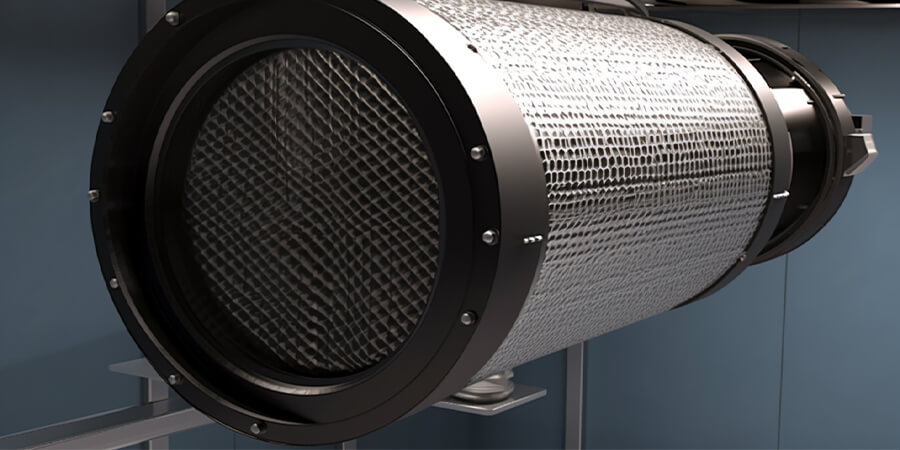

The second option is to cut a 6-inch (15.24cm) vent hole in the ceiling and exhaust the scrubbed air into the attic or out of a roof vent. In any scenario, the exhaust fan should exchange the air once every 1-3 minutes. To calculate the correct fan size for your room, calculate the room’s cubic footage / cubic meter (L x W x H) and select a fan with the appropriate cubic feet/meter per minute (CFM / m3/min) rating.
Exchanging and exhausting the air every 1-3 minutes creates a negative air pressure in the room, which will passively bring in fresh air and CO2 through the cracks in the room door. Long runs of ducting or ducting with numerous bends will decrease the stated CFM, so buy a fan with more power than you think you need.
For this design, we are going with the option of venting out of a roof vent. For this task, we will need our stud finder, tape measurer, bow compass, a jig saw, 6-inch (15.24cm) aluminum duct connector, ducting, worm gear duct clamps, J-bolts, string, carbon filter, and an exhaust fan.
Step 4: Room ventilation
Total Time Needed: 1 hour
- 01. Use the stud finder to find a good place in the ceiling between two joists to make a 6-inch (15.24cm) hole and mark it with a pencil and bow compass (8 minutes)
- 02. Cut the ceiling hole using the jigsaw (use safety glasses for protection) and insert the 6-inch (15.24cm) aluminum duct connector (10 minutes)
- 03. Use the stud finder to find a joist between your lights for mounting the carbon filter and fan (2 minutes)
- 04. Drill the pilot holes and insert your J-bolts (5 minutes)
- 05. Hang the carbon filter and fan. Smelly grow room air will be sucked through the carbon filter and exhausted through the ducting into the attic (5 minutes)
- 06. Map the route from the fan exhaust port to the hole in the ceiling. Locate the ceiling joists along that route and place a J-bolt every 3ft (91.5cm). (5 minutes)
- 07. Use string to attach the ducting to the J-bolts in the ceiling along the route running between the output end of the fan to the 6-inch(15.24cm) aluminum duct connector in the ceiling. (10 minutes)
- 08. (Bonus) Go into the attic and attach ducting to the 6-inch (15.24cm) aluminum duct connector popping up through the drywall. Attach this ducting to a roof vent, and now all of the cleaned air is released into the atmosphere for further dissipation (15 minutes)
Setting up fans
Moving air within the grow space is also essential to grow room design. Air movement is crucial to reduce micro-climates within the canopy, areas of stale moist air in the corners, and to strengthen branches so that they can support heavier buds. One of the well-known reasons to move air around the grow space is to reduce the opportunities for powdery mildew (PM) to land and grow on your plants.
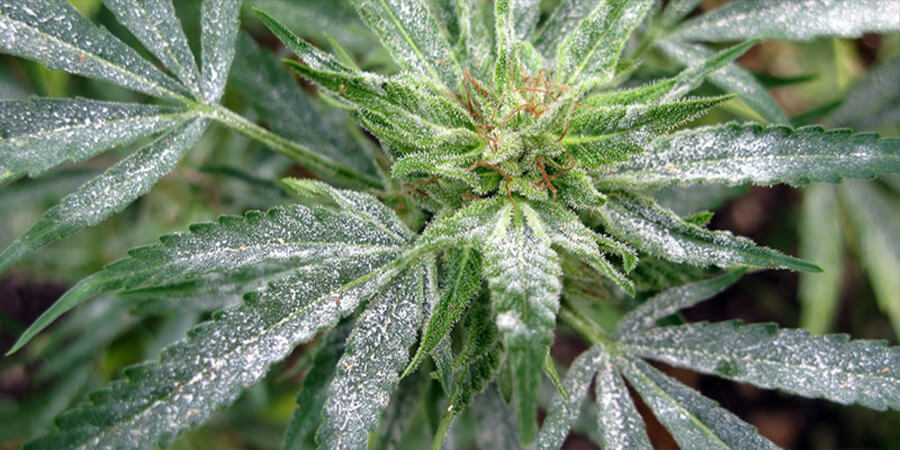

Place circulating fans on small stands, mounted to the walls or on the floor. At a minimum, you’ll want one fan moving air at the canopy level and another fan moving air below the canopy.
If you have a large room, fans may need to be placed on both sides of the room to ensure the middle section is getting good air movement. For a deeper understanding of the mechanics behind this and why good airflow is important, check out our article on Managing Airflow.
Step 5: Room circulation
Total Time Needed: 10 minutes
Remember to move air both above and below the canopy.
- . Place a fan in the corner (fans mounted to walls will create vibrations and low-frequency noise. This is not ideal if you have neighbors on the other side of that wall) and turn it on to a normal speed. Walk away from it; how far does the air push? (4 minutes)
- 02. Set up a fan on the opposite side of the room and turn it on. Do the two create enough air movement in the center? (4 minutes)
- 03. If satisfied, set the fans to oscillating and ensure that their spread is enough to reach the corners of the room (2 minutes)
Controlling temperature and humidity in your grow room
An advantage of using a room inside a house is that the temperature will generally be in an acceptable zone. There may be the need for cooling in the summer and a little added warmth in the winter, but for the most part, temperatures are controlled already. Most houses, however, don’t have features built-in to control humidity.
Small dehumidifiers meant for tents, RVs, and closets will not impact the humidity levels in a large room full of transpiring cannabis plants. Growers will need to invest in the 30 or 50-pint dehumidifiers. Conversely, humidifiers should have a large enough reservoir that they don’t require filling every few hours. Learn more of these important details in our article – Create the best climate for marijuana grow room.
Step 6: Climate control
Total Time Needed: 10 minutes
Because these devices draw significant wattage from the wall, avoid using them on the same outlet as the grow light if possible.
- 01. Determine the square footage (square meter) of your room by multiplying the length x width (2 minutes)
- 02. Select a dehumidifier and/or humidifier that exceeds the square footage (square meter) of the room, preferably doubled (8 minutes)
Safety and fire prevention
- The first rule in grow room safety is to have multiple smoke detectors in the garden space. I prefer one close to the lights and another near the canopy level.
- A licensed professional should conduct any and ALL electrical work. Never “wing it” with electricity.
- Do not place power strips or electrical connections on the ground where water can be spilled onto them; keep them elevated.
- If you have to use extension cords, the shorter, the better; don’t leave large coils of extension cords around.
- Keep any flammable materials away from the grow lights. This includes curtains, cords, and vegetation.
- Always keep a fresh fire extinguisher at the entrance of the indoor grow room.
- Use tape or twist-ties to secure loose cords to reduce tripping hazards.
Cleaning your grow room
“An ounce of prevention is worth a pound of cure,” goes the saying. It essentially means it is easier to prevent something than it is to repair the damage. This sentiment holds true to professional growers’ integrated pest management (IPM) strategies. Indoor grow rooms should always be free of loose soil, standing water, and leaf material. During a full grow cycle, there may be some stains on the floor or dirt accumulated in the corners. It is good IPM practice to clean the room between each cycle.
Cleaning products specific to cannabis grow rooms can be purchased, but the common cleaners are diluted bleach or cleaning vinegar. Wipe down everything from the walls to your soil containers to the shovel you use to scoop soil. Indoor grow rooms with a recent pest infestation should take extra measures, which may include not growing for up to a month to break the unwanted pests’ life cycle. You can learn more of these crop-saving tips in our article – How to Clean Your Grow Room.
Final thoughts on building a grow room
Designing a custom grow room for cannabis can be exciting. Now that you’ve read this article, you should know the many aspects to consider when designing a grow room and have the knowledge and confidence to make those choices.
If faced with a large blank canvas like an open room inside the house, I would use large grow tents instead of customizing the room. That is not always an option for growers due to availability or budget, and that is why we’ve created this article for designing an indoor grow room.
Remember, different areas of the house can call for different construction materials, tools, and techniques. Fortunately, we have specific articles for each of the main areas people grow. We also cover how to build a DIY grow tent if that is your preference. Regardless of where you decide to grow, for security purposes, cover the smell, block the light, and reduce mechanical noises that can give your grow away.
Designing the right grow room today can be the reason for future success. When a cannabis grow room is dialed in, all you need to do is grow like a pro. If you want to grow like a pro, all you need to do is download Roberts Grow Bible for free and get started on becoming a master grower.
Please let us know if you found this article or any other linked articles helpful in planning your grow room. Is there something we missed? We’d love to read your thoughts in the comment section. Have fun with your design plans, and happy gardening!
- SEO Powered Content & PR Distribution. Get Amplified Today.
- PlatoData.Network Vertical Generative Ai. Empower Yourself. Access Here.
- PlatoAiStream. Web3 Intelligence. Knowledge Amplified. Access Here.
- PlatoESG. Carbon, CleanTech, Energy, Environment, Solar, Waste Management. Access Here.
- PlatoHealth. Biotech and Clinical Trials Intelligence. Access Here.
- Source: https://www.ilovegrowingmarijuana.com/growing/indoors/how-to-build-a-cannabis-grow-room/
- :has
- :is
- :not
- :where
- $UP
- 1
- 10
- 15%
- 20
- 30
- 50
- 7
- 8
- 90
- 91
- a
- About
- above
- AC
- acceptable
- access
- accessible
- accessory
- Accounting
- Accumulated
- accuracy
- add
- added
- Additional
- Adds
- ADvantage
- advantages
- Adventure
- advice
- advised
- afraid
- AIR
- Air Conditioning
- aligned
- All
- allow
- allows
- along
- already
- also
- Although
- always
- amount
- an
- Anchor
- and
- annual
- Another
- answer
- any
- Apply
- appropriate
- ARE
- AREA
- areas
- around
- article
- articles
- AS
- ask
- aspect
- aspects
- At
- Atmosphere
- attach
- Automatic
- availability
- available
- avoid
- away
- back
- BE
- becoming
- been
- before
- begin
- Beginning
- behind
- being
- below
- benefit
- BEST
- Better
- between
- Big
- Big Picture
- Bit
- blank
- Block
- Bolt
- Bonus
- both
- Both Sides
- Bottom
- boxes
- branches
- Break
- bring
- budget
- buds
- build
- Building
- built-in
- but
- buy
- by
- calculate
- calculated
- call
- CAN
- cannabis
- Canopy
- canvas
- carbon
- carpet
- ceiling
- Center
- centered
- CFM
- chain
- challenging
- check
- Children
- choices
- Choose
- circulating
- clean
- Cleaning
- Climate
- Close
- closed
- co2
- COM
- combat
- comes
- coming
- comment
- Common
- commonly
- company
- compared
- Compass
- complete
- concrete
- Conduct
- confidence
- Connect
- Connecting
- Connections
- Cons
- Consider
- considerations
- considered
- construct
- constructing
- construction
- Consumers
- Containers
- control
- controlled
- controlling
- conversely
- convert
- converting
- Corner
- corners
- correct
- Corrections
- correctly
- Cost
- Costs
- Couple
- cover
- covered
- covering
- create
- created
- creates
- crucial
- cure
- curious
- curtain
- custom
- customization
- customize
- Cut
- cycle
- damage
- Days
- decades
- decide
- Deciding
- decrease
- deeper
- Depending
- described
- Design
- designing
- designs
- desired
- details
- Determine
- determining
- Devices
- different
- diluted
- dimensions
- dirt
- distance
- divided
- Diy
- do
- does
- Doesn’t
- doing
- done
- Dont
- Door
- doors
- down
- downside
- dozens
- draw
- Drop
- dry
- due
- during
- e
- each
- Earlier
- easier
- easiest
- efficiency
- electricity
- elevated
- empty
- end
- enough
- ensure
- Entire
- entrance
- Environment
- equal
- equipment
- escape
- essential
- essentially
- Every
- everything
- example
- exceeds
- excellent
- exchange
- exciting
- exist
- existing
- exists
- experience
- extend
- extension
- extra
- extraction
- extreme
- faced
- faces
- facing
- fact
- factors
- family
- fan
- fans
- far
- Features
- few
- fight
- filling
- Film
- filter
- filters
- Find
- Finder
- Fire
- First
- fit
- five
- flat
- Floor
- floors
- fluctuations
- Footprint
- For
- Fortunately
- found
- four
- FRAME
- Free
- fresh
- from
- front
- full
- fully
- fun
- further
- future
- gaps
- garage
- Garden
- Gear
- generally
- get
- getting
- Give
- glass
- glasses
- Go
- Goes
- going
- good
- got
- Ground
- Grow
- growers
- Growing
- grown
- Grows
- Growth
- guidance
- guide
- Hall
- Hang
- happy
- harbor
- Have
- head
- help
- helpful
- helps
- Highlighted
- highlights
- hold
- holds
- Hole
- Holes
- Home
- hour
- HOURS
- House
- houses
- How
- How To
- However
- HTTPS
- Hundreds
- hung
- hydroponic
- i
- ideal
- if
- Impact
- important
- in
- in-depth
- include
- includes
- Increase
- Indoor
- information
- inside
- installing
- instance
- instead
- instrument
- integrated
- intend
- intended
- interior
- Intimidate
- into
- Invest
- involves
- IT
- items
- jigsaw
- jpg
- just
- Keep
- kids
- Know
- knowledge
- labor
- ladder
- Land
- large
- larger
- lay
- lead
- leak
- Leaks
- LEARN
- least
- Leave
- left
- Length
- less
- let
- Level
- levels
- Licensed
- Life
- light
- Lighting
- like
- likely
- Line
- LINK
- linked
- List
- Lists
- little
- live
- living
- load
- located
- location
- locations
- Long
- Look
- looking
- LOOKS
- love
- lower
- Main
- major
- make
- Making
- management
- managing
- many
- map
- marijuana
- mark
- master
- material
- materials
- max-width
- May..
- means
- meant
- measure
- measures
- measuring
- mechanical
- mechanics
- micro
- Middle
- might
- mind
- minimum
- minute
- minutes
- missed
- Mitigate
- Month
- more
- most
- move
- movement
- moving
- much
- multiple
- multiplying
- my
- Nature
- Near
- Need
- needed
- needs
- negative
- neighbors
- never
- New
- newly
- no
- Noise
- normal
- North
- now
- number
- numerous
- of
- off
- Offers
- on
- once
- ONE
- only
- open
- operation
- opportunities
- opposite
- Option
- Options
- or
- Other
- our
- out
- Outdoor
- outlet
- Outlets
- output
- outside
- over
- overnight
- own
- paint
- painting
- part
- Patch
- path
- pathways
- People
- per
- perfect
- Perpetual
- Pets
- pick
- picture
- pieces
- pilot
- Place
- placed
- placement
- Places
- plan
- planning
- plans
- plant
- plants
- plato
- Plato Data Intelligence
- PlatoData
- please
- pm
- pockets
- points
- poses
- position
- possible
- potential
- pound
- power
- practice
- prefer
- Premium
- preparation
- pressure
- prevent
- Prevention
- Pro
- Problem
- problems
- procedure
- process
- Products
- professional
- proper
- properly
- properties
- PROS
- protect
- protection
- provide
- provides
- purchase
- purchased
- purposes
- Push
- quality
- Quick
- raise
- rating
- reach
- Read
- Reading
- ready
- reason
- reasons
- recent
- recommended
- reduce
- reducing
- reflect
- Regardless
- relatively
- released
- remember
- remove
- Removed
- repair
- require
- Requirements
- Resistance
- retain
- Rewards
- right
- roof
- Room
- Rooms
- Route
- Rule
- Run
- running
- runs
- s
- Safety
- same
- satisfied
- saved
- saw
- say
- saying
- scenario
- scoop
- Second
- Section
- sections
- secure
- Secured
- security
- selected
- sentiment
- set
- several
- shared
- sharing
- sheet
- should
- side
- Sides
- signals
- significant
- similar
- Simple
- simultaneously
- Size
- sizes
- small
- smaller
- Smell
- Smoke
- So
- soil
- solution
- some
- Someone
- something
- Source
- South
- Space
- spaces
- special
- specific
- speed
- spread
- square
- stand
- standing
- stands
- started
- stated
- Steps
- Still
- Stir
- Strains
- strategies
- street
- Strengthen
- stress
- String
- style
- styles
- succeed
- success
- such
- Suit
- summer
- Sun
- support
- Surface
- susceptible
- Sweep
- Swings
- system
- Systems
- Take
- takes
- tape
- Task
- techniques
- ten
- tent
- than
- that
- The
- The Area
- the information
- their
- Them
- then
- There.
- therefore
- These
- they
- things
- think
- this
- those
- three
- Through
- Thus
- tighten
- time
- tips
- Title
- titled
- to
- today
- tools
- top
- topic
- Total
- true
- TURN
- Turned
- tutorial
- two
- typically
- understanding
- unfortunately
- unlikely
- unwanted
- us
- use
- used
- using
- usually
- utilize
- utilized
- variety
- various
- verify
- very
- vision
- Visit
- Visits
- vs
- W
- walk
- Wall
- want
- wants
- warmth
- Water
- watering
- Way..
- ways
- we
- weed
- WELL
- well-known
- when
- which
- while
- white
- WHO
- why
- will
- window
- windows
- Winter
- wipe
- with
- within
- without
- wood
- Work
- worked
- worm
- worth
- would
- X
- you
- Your
- zephyrnet

